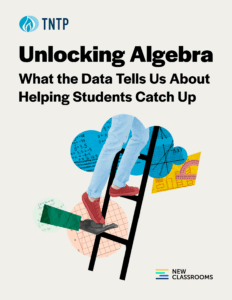Over the last four years, a small group of districts in Tennessee has been testing an idea that could help change the way we teach reading to students across the country: that a strong early-grade literacy curriculum paired with the right resources and support for teachers can lead to big gains for students. With support from TNTP and Tennessee SCORE, these districts, part of the Leading Innovation for Tennessee Education (LIFT) network, selected standards-aligned instructional materials that reflect the latest science on how children learn to read.
But this was where the most challenging work started—because even the best curriculum is only as good as its implementation. Adopting the new materials required teachers to understand them, trust the process, and deliver lessons with integrity, creativity and high expectations. That’s why the LIFT districts made building buy-in for new curricula and planning extensive support for school leaders and teachers the centerpiece of their work.
More than anything, that meant fostering and tapping into the power of community—something you rarely hear about in research and discussions about curriculum and instructional materials. Schools in the LIFT districts found that adopting a new curriculum provided new opportunities to foster collaboration, between groups of teachers and between teachers and the school leaders who support them. Teachers across the districts worked within and across grade levels to understand how a stronger curriculum could bring a shared vision for literacy instruction to life. This vision, along with common materials and common routines for preparing lessons, analyzing student work, and reflecting on outcomes, helped build a foundation for even deeper collaboration around a concrete “what”—the rigorous content of the curricular materials.
But the true power of LIFT’s approach lies in its ability to knit together communities not just at schools or across schools, but across multiple districts. District leaders need their equivalent of the “teacher across the hall” with whom to confide, share ideas and problem solve. Through the LIFT network, district strategy leads meet regularly in convenings organized around specific challenges, like deepening understanding of effective literacy practices and analyzing and reflecting on implementation results.
These convenings have led to some great learning and strategies, but also to important relationships and a community of practitioners engaged in the same work. LIFT leaders (superintendents and district or school leaders) have a network of “phone-a-friends” across the state they can call on to share resources and trade ideas. Groups of leaders often co-present at conferences and bring caravans of teachers and principals to visit one another’s districts and classrooms, deepening the impact of the work statewide.
A testament to the power of these networks is the success of three districts who joined LIFT two years after the work began. These new districts were paired with an existing “mentor district” who could show them the ropes of curriculum implementation and point out pitfalls. With this extra help, the new districts achieved even higher student growth than their mentor districts in the first year of implementation. District mentorship is uncharted territory compared to teacher and even principal mentorship, but LIFT’s results suggest it could be a key to implementing stronger curricula at scale.
The LIFT districts are already seeing impressive results from this work. Last year, 8 of the 12 districts had seen increases in the number of third-grade students scoring at least an “on track” rating on the state’s English Language Arts test. Every LIFT district had at least one school that exceeded academic growth expectations, and twenty schools from across the network made enough progress to be designated “reward schools” by the state. Just as importantly, nearly seven in 10 teachers in the LIFT districts agreed that their students’ reading and listening comprehension were growing noticeably as a result of the new instructional materials.
If replicated widely, it’s the kind of progress that could put millions of students on an entirely different path in school and in their lives. And leaders of the LIFT districts are beginning to use the power of their community to advocate for stronger literacy instruction across the country. They authored a powerful guidebook outlining the values and benchmarks around their curriculum work. They amplify each other on social media and co-author articles about their work. This group of LIFT leaders form the core of the Curriculum Matters campaign, sharing their stories with school and district leaders across the country.
Other school systems can draw a clear lesson from the experience the LIFT network: big gains in early literacy are possible with strong instructional materials, but only with the support and structures to foster communities of teachers, school leaders, and district leaders working toward a shared vision. The “teacher across the hall” can make all the difference—even if they aren’t across the hall.







